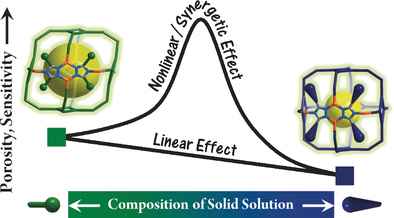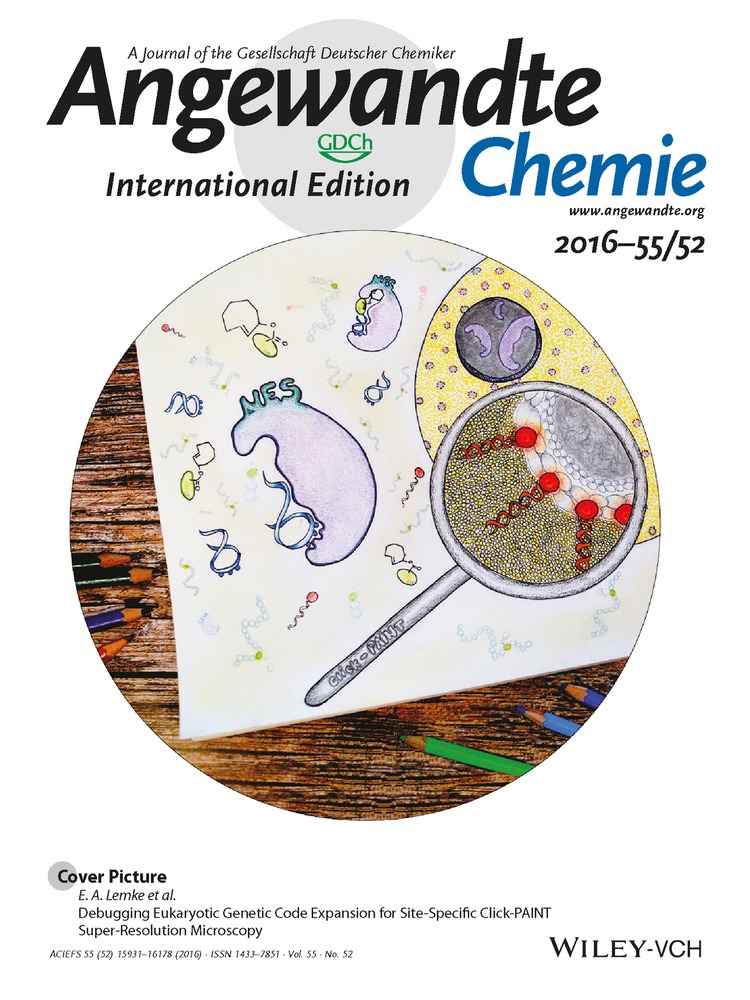Flexible, Luminescent Metal–Organic Frameworks Showing Synergistic Solid-Solution Effects on Porosity and Sensitivity
Si-Yang Liu
MOE Key Laboratory of Bioinorganic and Synthetic Chemistry, School of Chemistry, Sun Yat-Sen University, Guangzhou, 510275 China
Search for more papers by this authorDr. Dong-Dong Zhou
MOE Key Laboratory of Bioinorganic and Synthetic Chemistry, School of Chemistry, Sun Yat-Sen University, Guangzhou, 510275 China
Search for more papers by this authorDr. Chun-Ting He
MOE Key Laboratory of Bioinorganic and Synthetic Chemistry, School of Chemistry, Sun Yat-Sen University, Guangzhou, 510275 China
Search for more papers by this authorDr. Pei-Qin Liao
MOE Key Laboratory of Bioinorganic and Synthetic Chemistry, School of Chemistry, Sun Yat-Sen University, Guangzhou, 510275 China
Search for more papers by this authorDr. Xiao-Ning Cheng
Instrumental Analysis and Research Center, Sun Yat-Sen University, Guangzhou, 510275 China
Search for more papers by this authorYan-Tong Xu
MOE Key Laboratory of Bioinorganic and Synthetic Chemistry, School of Chemistry, Sun Yat-Sen University, Guangzhou, 510275 China
Search for more papers by this authorJia-Wen Ye
MOE Key Laboratory of Bioinorganic and Synthetic Chemistry, School of Chemistry, Sun Yat-Sen University, Guangzhou, 510275 China
Search for more papers by this authorCorresponding Author
Prof. Dr. Jie-Peng Zhang
MOE Key Laboratory of Bioinorganic and Synthetic Chemistry, School of Chemistry, Sun Yat-Sen University, Guangzhou, 510275 China
Search for more papers by this authorProf. Dr. Xiao-Ming Chen
MOE Key Laboratory of Bioinorganic and Synthetic Chemistry, School of Chemistry, Sun Yat-Sen University, Guangzhou, 510275 China
Search for more papers by this authorSi-Yang Liu
MOE Key Laboratory of Bioinorganic and Synthetic Chemistry, School of Chemistry, Sun Yat-Sen University, Guangzhou, 510275 China
Search for more papers by this authorDr. Dong-Dong Zhou
MOE Key Laboratory of Bioinorganic and Synthetic Chemistry, School of Chemistry, Sun Yat-Sen University, Guangzhou, 510275 China
Search for more papers by this authorDr. Chun-Ting He
MOE Key Laboratory of Bioinorganic and Synthetic Chemistry, School of Chemistry, Sun Yat-Sen University, Guangzhou, 510275 China
Search for more papers by this authorDr. Pei-Qin Liao
MOE Key Laboratory of Bioinorganic and Synthetic Chemistry, School of Chemistry, Sun Yat-Sen University, Guangzhou, 510275 China
Search for more papers by this authorDr. Xiao-Ning Cheng
Instrumental Analysis and Research Center, Sun Yat-Sen University, Guangzhou, 510275 China
Search for more papers by this authorYan-Tong Xu
MOE Key Laboratory of Bioinorganic and Synthetic Chemistry, School of Chemistry, Sun Yat-Sen University, Guangzhou, 510275 China
Search for more papers by this authorJia-Wen Ye
MOE Key Laboratory of Bioinorganic and Synthetic Chemistry, School of Chemistry, Sun Yat-Sen University, Guangzhou, 510275 China
Search for more papers by this authorCorresponding Author
Prof. Dr. Jie-Peng Zhang
MOE Key Laboratory of Bioinorganic and Synthetic Chemistry, School of Chemistry, Sun Yat-Sen University, Guangzhou, 510275 China
Search for more papers by this authorProf. Dr. Xiao-Ming Chen
MOE Key Laboratory of Bioinorganic and Synthetic Chemistry, School of Chemistry, Sun Yat-Sen University, Guangzhou, 510275 China
Search for more papers by this authorGraphical Abstract
Beyond mixing: The proper combination of non-isostructural metal–organic frameworks in terms of solid solutions can drastically improve the porosity (150 %) and optical O2 sensitivity (410 times) compared with the original phases. An oxygen-sensing MOF (MAF-2) can undergo structure changes and property improvements when its molecular building blocks are mixed and solid solutions are formed.
Abstract
Mixing molecular building blocks in the solid solution manner is a valuable strategy to obtain structures and properties in between the isostructural parent metal–organic frameworks (MOFs). We report nonlinear/synergistic solid-solution effects using highly related yet non-isostructural, phosphorescent CuI triazolate frameworks as parent phases. Near the phase boundaries associated with conformational diversity and ligand heterogeneity, the porosity (+150 %) and optical O2 sensitivity (410 times, limit of detection 0.07 ppm) can be drastically improved from the best-performing parent MOFs and even exceeds the records hold by precious-metal complexes (3 ppm) and C70 (0.2 ppm).
Supporting Information
As a service to our authors and readers, this journal provides supporting information supplied by the authors. Such materials are peer reviewed and may be re-organized for online delivery, but are not copy-edited or typeset. Technical support issues arising from supporting information (other than missing files) should be addressed to the authors.
| Filename | Description |
|---|---|
| anie201608439-sup-0001-misc_information.pdf1.1 MB | Supplementary |
Please note: The publisher is not responsible for the content or functionality of any supporting information supplied by the authors. Any queries (other than missing content) should be directed to the corresponding author for the article.
References
- 1
- 1aM. D. Allendorf, C. A. Bauer, R. K. Bhakta, R. J. T. Houk, Chem. Soc. Rev. 2009, 38, 1330–1352;
- 1bP. Deria, J. E. Mondloch, O. Karagiaridi, W. Bury, J. T. Hupp, O. K. Farha, Chem. Soc. Rev. 2014, 43, 5896–5912;
- 1cZ. Hu, B. J. Deibert, J. Li, Chem. Soc. Rev. 2014, 43, 5815–5840;
- 1dY. J. Cui, B. Li, H. J. He, W. Zhou, B. L. Chen, G. D. Qian, Acc. Chem. Res. 2016, 49, 483–493.
- 2
- 2aW. Lu, Z. Wei, Z. Y. Gu, T. F. Liu, J. Park, J. Park, J. Tian, M. Zhang, Q. Zhang, T. Gentle III, M. Bosch, H. C. Zhou, Chem. Soc. Rev. 2014, 43, 5561–5593;
- 2bV. Guillerm, D. Kim, J. F. Eubank, R. Luebke, X. Liu, K. Adil, M. S. Lah, M. Eddaoudi, Chem. Soc. Rev. 2014, 43, 6141–6172.
- 3H. Furukawa, U. Müller, O. M. Yaghi, Angew. Chem. Int. Ed. 2015, 54, 3417–3430; Angew. Chem. 2015, 127, 3480–3494.
- 4
- 4aD. Rankine, T. D. Keene, C. J. Doonan, C. J. Sumby, Cryst. Growth Des. 2014, 14, 5710–5718;
- 4bS. Y. Zhang, W. Shi, P. Cheng, M. J. Zaworotko, J. Am. Chem. Soc. 2015, 137, 12203–12206.
- 5J.-P. Zhang, A.-X. Zhu, R.-B. Lin, X.-L. Qi, X.-M. Chen, Adv. Mater. 2011, 23, 1268–1271.
- 6X.-L. Qi, S.-Y. Liu, R.-B. Lin, P.-Q. Liao, J.-W. Ye, Z. Lai, Y. Guan, X.-N. Cheng, J.-P. Zhang, X.-M. Chen, Chem. Commun. 2013, 49, 6864–6866.
- 7
- 7aS. Mohapatra, S. Adhikari, H. Riju, T. K. Maji, Inorg. Chem. 2012, 51, 4891–4893;
- 7bC. K. Brozek, M. Dincă, J. Am. Chem. Soc. 2013, 135, 12886–12891;
- 7cG. Mukherjee, K. Biradha, Chem. Commun. 2014, 50, 670–672;
- 7dL. M. Aguirre-Díaz, F. Gándara, M. Iglesias, N. Snejko, E. Gutiérrez-Puebla, M. Á. Monge, J. Am. Chem. Soc. 2015, 137, 6132–6135;
- 7eL. Wang, Y. Wu, R. Cao, L. Ren, M. Chen, X. Feng, J. Zhou, B. Wang, ACS Appl. Mater. Interfaces 2016, 8, 16736–16743.
- 8
- 8aT. Fukushima, S. Horike, Y. Inubushi, K. Nakagawa, Y. Kubota, M. Takata, S. Kitagawa, Angew. Chem. Int. Ed. 2010, 49, 4820–4824; Angew. Chem. 2010, 122, 4930–4934;
- 8bS. Horike, Y. Inubushi, T. Hori, T. Fukushima, S. Kitagawa, Chem. Sci. 2012, 3, 116–120.
- 9
- 9aH. Deng, C. J. Doonan, H. Furukawa, R. B. Ferreira, J. Towne, C. B. Knobler, B. Wang, O. M. Yaghi, Science 2010, 327, 846–850;
- 9bC. Martí-Gastaldo, D. Antypov, J. E. Warren, M. E. Briggs, P. A. Chater, P. V. Wiper, G. J. Miller, Y. Z. Khimyak, G. R. Darling, N. G. Berry, M. J. Rosseinsky, Nat. Chem. 2014, 6, 343–351;
- 9cY. B. Zhang, H. Furukawa, N. Ko, W. Nie, H. J. Park, S. Okajima, K. E. Cordova, H. Deng, J. Kim, O. M. Yaghi, J. Am. Chem. Soc. 2015, 137, 2641–2650;
- 9dQ.-G. Zhai, X. Bu, C. Mao, X. Zhao, P. Feng, J. Am. Chem. Soc. 2016, 138, 2524–2527.
- 10X.-D. Wang, O. S. Wolfbeis, Chem. Soc. Rev. 2014, 43, 3666–3761.
- 11
- 11aD. Liu, K. Lu, C. Poon, W. Lin, Inorg. Chem. 2014, 53, 1916–1924;
- 11bB. Manna, A. K. Chaudhari, B. Joarder, A. Karmakar, S. K. Ghosh, Angew. Chem. Int. Ed. 2013, 52, 998–1002; Angew. Chem. 2013, 125, 1032–1036;
- 11cB. Manna, A. K. Chaudhari, B. Joarder, A. Karmakar, S. K. Ghosh, Angew. Chem. Int. Ed. 2013, 52, 998–1002; Angew. Chem. 2013, 125, 1032–1036;
- 11dJ.-H. Wang, M. Li, D. Li, Chem. Sci. 2013, 4, 1793;
- 11eA. Mallick, B. Garai, M. A. Addicoat, P. S. Petkov, T. Heine, R. Banerjee, Chem. Sci. 2015, 6, 1420–1425;
- 11fZ. Xie, L. Ma, K. E. deKrafft, A. Jin, W. Lin, J. Am. Chem. Soc. 2010, 132, 922–923;
- 11gR.-B. Lin, F. Li, S.-Y. Liu, X.-L. Qi, J.-P. Zhang, X.-M. Chen, Angew. Chem. Int. Ed. 2013, 52, 13429–13433; Angew. Chem. 2013, 125, 13671–13675;
- 11hZ. S. Dou, J. C. Yu, Y. J. Cui, Y. Yang, Z. Y. Wang, D. R. Yang, G. D. Qian, J. Am. Chem. Soc. 2014, 136, 5527–5530;
- 11iR. Xu, Y. Wang, X. Duan, K. Lu, D. Micheroni, A. Hu, W. Lin, J. Am. Chem. Soc. 2016, 138, 2158–2161.
- 12S.-Y. Liu, X.-L. Qi, R.-B. Lin, X.-N. Cheng, P.-Q. Liao, J.-P. Zhang, X.-M. Chen, Adv. Funct. Mater. 2014, 24, 5866–5872.
- 13D. M. Oglesby, C. K. Puram, B. T. Upchurch, NASA Tech. Memo. 1998, 4695. The lower and upper bounds of PDR are defined as the concentrations giving 80 % and 20 % of the intensity in vacuum, respectively.
- 14X. Lu, M. A. Winnik, Chem. Mater. 2001, 13, 3449–3463.
- 15J.-P. Zhang, X.-M. Chen, J. Am. Chem. Soc. 2008, 130, 6010–6017.
- 16J.-P. Zhang, S.-L. Zheng, X.-C. Huang, X.-M. Chen, Angew. Chem. Int. Ed. 2004, 43, 206–209; Angew. Chem. 2004, 116, 208–211.
- 17Y.-H. Wang, H. Xu, G. Yang, H.-W. Hou, J. Chem. Crystallogr. 2011, 41, 434–437.
- 18
- 18aA. Schneemann, V. Bon, I. Schwedler, I. Senkovska, S. Kaskel, R. A. Fischer, Chem. Soc. Rev. 2014, 43, 6062–6096;
- 18bP. Horcajada, C. Serre, G. Maurin, N. A. Ramsahye, F. Balas, M. Vallet-Regi, M. Sebban, F. Taulelle, G. Ferey, J. Am. Chem. Soc. 2008, 130, 6774–6780;
- 18cW. Yang, A. J. Davies, X. Lin, M. Suyetin, R. Matsuda, A. J. Blake, C. Wilson, W. Lewis, J. E. Parker, C. C. Tang, M. W. George, P. Hubberstey, S. Kitagawa, H. Sakamoto, E. Bichoutskaia, N. R. Champness, S. Yang, M. Schröder, Chem. Sci. 2012, 3, 2993;
- 18dS. Krause, V. Bon, I. Senkovska, U. Stoeck, D. Wallacher, D. M. Tobbens, S. Zander, R. S. Pillai, G. Maurin, F. X. Coudert, S. Kaskel, Nature 2016, 532, 348–352.
- 19J. P. Zhang, Y. Y. Lin, X. C. Huang, X. M. Chen, Dalton Trans. 2005, 3681–3685.
- 20
- 20aA. Mills, A. Lepre, Anal. Chem. 1997, 69, 4653–4659;
- 20bS. Kochmann, C. Baleizao, M. N. Berberan-Santos, O. S. Wolfbeis, Anal. Chem. 2013, 85, 1300–1304;
- 20cS. Nagl, C. Baleizao, S. M. Borisov, M. Schaferling, M. N. Berberan-Santos, O. S. Wolfbeis, Angew. Chem. Int. Ed. 2007, 46, 2317–2319; Angew. Chem. 2007, 119, 2368–2371;
- 20dS. Nagl, C. Baleizão, S. M. Borisov, M. Schäferling, M. N. Berberan-Santos, O. S. Wolfbeis, Angew. Chem. Int. Ed. 2007, 46, 2317–2319; Angew. Chem. 2007, 119, 2368–2371.
- 21J.-P. Zhang, X.-M. Chen, J. Am. Chem. Soc. 2009, 131, 5516–5521.





